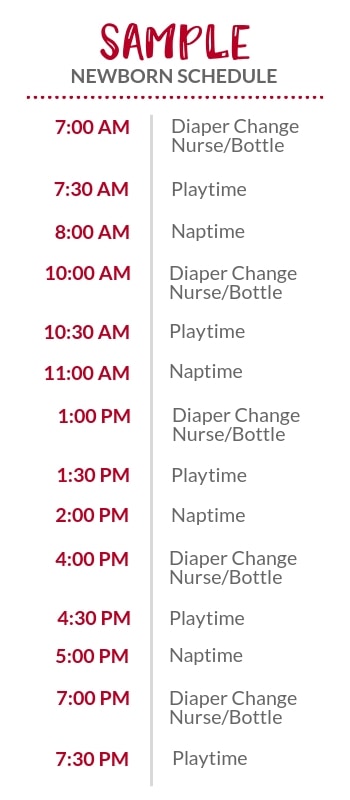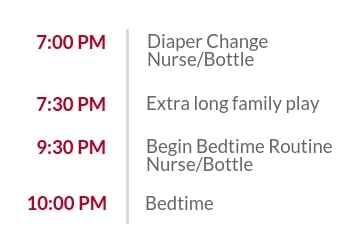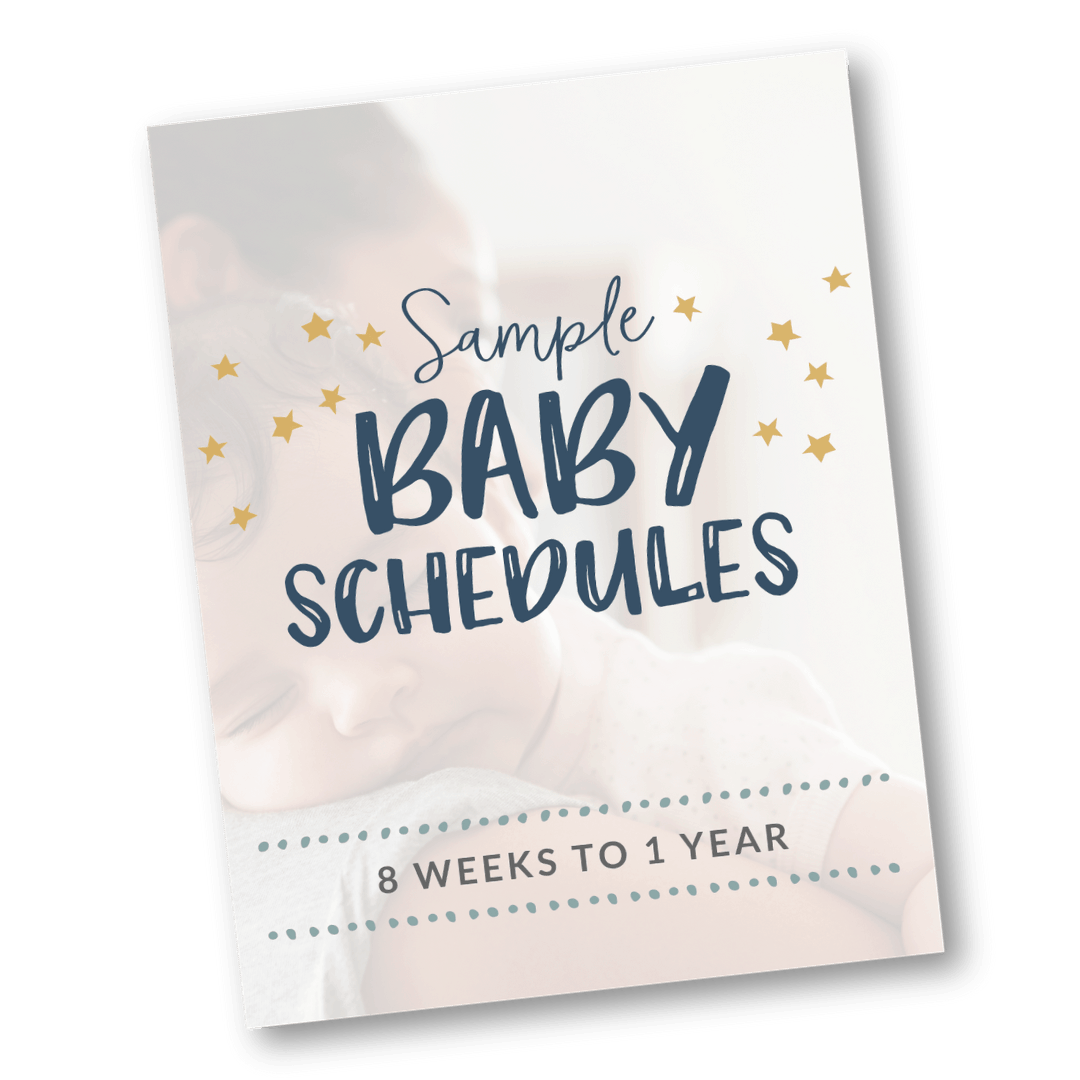
I’ll be honest with you, a newborn sleep schedule has less to do with you and more to do with your newborn.
In fact, a newborn schedule in the first 4 weeks doesn’t look too much like a schedule. There’s no napping appointment at 9:30. No “bottle at 11” to check off the list.
If a standard schedule is like playing Bach, a newborn sleep schedule would be improvising jazz. Both schedules have the same general notes to follow (feeding your baby, napping, etc.), but at the end of the jam-session they sound completely different.
Goals For Your Newborn Sleep Schedule
We have three goals to focus on with our newborn sleep schedule. They are…
- Learn what are the typical rhythms of eating and sleeping newborn babies go through. This helps you know roughly what to expect.
- Learn the difference between “napping” and “habituating”
- Learn how to adjust a sample newborn schedule to fit your baby’s preferences and needs.
This newborn schedule has been designed for full-term babies. If your baby was born premature, certain adjustments will be required. I teach how to do that in my milestone book.
A Newborn’s Natural Rhythm
For the first week, your infant is going to be sleeping about 16-18 hours every day. (Doing the math…this means she’ll be awake for only 6-8 hours, and half of that is eating.)
By week four, she’ll adjust to sleeping around 15-17 hours a day (7-9 waking hours), and get up about 2-3 times during the night to eat.
For breastfeeding moms, you can expect her to eat every 1.5 hours (minimum) to 3 hours (maximum). Don’t allow her to go longer than 3 hours between feedings or your milk may suffer and she may not gain weight.
For formula feeding parents, your baby will eat less often. Expect her to chug 2-3 ounces every three to four hours.
The Sneaky Snacker
If you find yourself breastfeeding your newborn every hour or so, you may be satisfying a Sneaky Snacker. Next time she eats, watch her closely. Can you see her jaw clearly dropping and hear her swallowing? If so, find a local lactation consultant who can help you make sure your milk supply is staying up with demand.
Napping vs. Habituating
You have an enemy. An enemy who can transform a happy content baby into a fussy, unsootheable monster within just 30 minutes. It’s the cunningly destructive Captain O.
Also known as Overstimulation.
How much power does Captain O have over your newborn? Depends. Some temperaments are more sensitive than others. And honestly, since you’ve only really known your infant for a few weeks (if that) it’s going to be difficult to tell how susceptible she will be to the powers of Captain O.
Observation is your best offense against Captain O.
Identifying Captain Overstimulation
When you think about it, it’s not surprising that newborns are so easily overstimulated. She just spent 9 months in a warm, dark, muffled place. No bright lights. No jarring noises. If you’ve spent more than 30 minutes trying to calm your little bundle, your very attempts to soothe may have overstimulated her.
Swaddle her up, lay her down in her crib with the lights dim, and give her a few seconds to calm down. Oftentimes the sudden lack of sound or movement will surprise and soothe her.
This may not work all the time, especially if your baby is struggling with acid reflux or colic, but is still worth the try.
The Dangers of Habituating
Habituating is a term The Sleep Lady uses to describe when a newborn is “fake napping”.
Basically, your infant is verging on the brink of overstimulation, and so shuts down. She looks like she’s sleeping, but really she’s trying to self-soothe. It’s common for babies until they are 6-8 weeks old.
How do you know if your newborn is habituating? She will wake fussy and irritable, like she hardly slept at all. (Yeah, I know. That’s no flashing neon sign.)
If your newborn can’t find quiet tranquility during the day (constantly habituating), she will seek it at night. This means she’ll be alert and ready for play when you want to be unconscious on a pillow.
Your best defense is an offense: prevent the need for her to habituate in the first place. So try your darndest in those first four weeks to keep your baby isolated from the bright and noisy Captain O. Get a good noisemaker to drown out active siblings. Stay home as much as possible. (Whispering would be overkill.)
A Sample Newborn Schedule for the First 4 to 6 Weeks
Like I mentioned at the beginning of this post, your newborn schedule should sound like JAZZ, not BACH. Remember, you want to catch her natural rhythms. Use the times listed as “suggestions” to when you may spot her hunger and sleep cues.
This sample newborn schedule to rotates every 3 hours. Thirty minutes of feeding, thirty minutes of playing, and then a two hour nap. (With one exception at the end.) If your baby shows signs of being hungry or needing to sleep, give her what she needs and then adjust your newborn schedule from that new time.
I highly recommend keeping a baby journal. It will help you keep track times (which you won’t remember, trust me) and allow you to easily look back and pick out her emerging natural patterns.
Patterns like, She always gets tired around 9:30 am, or She sleeps better after a 45 minute playtime… and other important cues.

At this point in the newborn sleep schedule, we make a few adjustments. You want her last feeding of the day and your bedtime to match to maximize sleeping time for you both, somewhere around 10:00 or 11:00 pm.
So, to help give that last nudge of getting-ready-for-longer-nighttime-sleep, try to keep her awake for one or two hours before bedtime. (This is great Daddy bonding time!)
If she can’t make it to 10 or 11pm, feed her and put her to bed earlier, keeping track of her signals and times for future reference.
To continue our sample newborn schedule, let’s begin again at the 7:00 pm wakeup…

As you can see, the last playtime of the day is extended (if possible) to 2 hours instead of the usual 30 minutes.
The danger, again, is overstimulation (Captain O strikes again!) you have to lay her down for bed while she’s tired, but not too tired. If she’s too tired, she’ll have a hard time calming down to sleep.
Tracking your newborn schedule and habits in a notebook or baby tracker can teach you what her “moving to exhausted” signs are. The sooner you jump on those, the easier getting her to sleep is going to be.
Want another perspective on what a newborn schedule can look like Julie over at Jules and Co. gives an example of what her newborn’s daily routine looks like, along with a free printable to hang on your fridge. Check it out here.
Free Sleep Schedules
The Overnight Newborn Sleep Schedule
Once she’s down for the evening, don’t wake her unless it’s been longer than 3-4 hours. At this young age, you don’t want her to “sleep through the night”. It’s not healthy for her.
When she starts stirring for a meal, probably around 1 am (if your last feeding was 9:30), feed her in near darkness with little sound or movement.
Unless she’s got a poopy diaper, has leaked, or has a bad diaper rash, lay her back down to sleeping without a diaper change. There’s nothing like cold air on a cute bum to overstimulate and ruin your sleeping chances!
Your Next Step
Now that you’ve got a good idea about what your newborn sleep schedule should look like, let me depress you a little.
Next month it all changes. But I’ve got your back. Get your cheating schedule for the next month. And while you’re cheating, check out my 62 tricks to encourage sleepiness.
Be patiently persistent! And remember…with every day your newborn gets bigger and bigger, which means that tiny tummy is getting bigger and bigger…which means she can sleep longer and longer!
Have You Read These Yet?
We Love Citations
Newborn Sleep: How Much is Enough? SleepLady.com
REM Sleep Cycle of Your Baby. NestedBean.com
Newborn Sleep Patterns. StanfordChildrens.org
We ♥ honesty! This post contains affiliate links that provide extra money for our mutual coffee habits addictions. Click here to learn more. As an Amazon Associate I earn from qualifying purchases.





